 Navy Field Navy Field
by George Ross
April 30, 2006

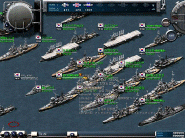 Those of you who’ve heard anything of PC gaming in Korea have doubtless
heard of that country’s fascination with StarCraft and competitive MMO games.
Characterized by a large number of players in one arena, fierce rivalries
where the quick-thinking win, and of course, micromanagement by the heaps. As
a game initially designed for the Korean market, Navy Field definitely hits
on all three of those points. Otherwise, it’s hard to characterize what Navy
Field is in terms of genre – it definitely stands in a category of its own.
It could possibly be described as ‘Massively-Multiplayer Real-Time 2-D
3rd-Person World War II “Battleship” (yes, the paper game) Action
Simulation’. In a nutshell, there are two main parts to the game. The first
is the harbor, where you equip, upgrade and tweak your ship for combat. The second is the combat itself where you use that ship to fight in a team
against other players, earning points and experience for your crew which
will allow you to get better stuff and better ships. With four nations, six
classes, and dozens of ship types to choose from, you get about as much
variety as World War II fleet combat has to offer. Those of you who’ve heard anything of PC gaming in Korea have doubtless
heard of that country’s fascination with StarCraft and competitive MMO games.
Characterized by a large number of players in one arena, fierce rivalries
where the quick-thinking win, and of course, micromanagement by the heaps. As
a game initially designed for the Korean market, Navy Field definitely hits
on all three of those points. Otherwise, it’s hard to characterize what Navy
Field is in terms of genre – it definitely stands in a category of its own.
It could possibly be described as ‘Massively-Multiplayer Real-Time 2-D
3rd-Person World War II “Battleship” (yes, the paper game) Action
Simulation’. In a nutshell, there are two main parts to the game. The first
is the harbor, where you equip, upgrade and tweak your ship for combat. The second is the combat itself where you use that ship to fight in a team
against other players, earning points and experience for your crew which
will allow you to get better stuff and better ships. With four nations, six
classes, and dozens of ship types to choose from, you get about as much
variety as World War II fleet combat has to offer.
While the game itself is far from as exotic as it might sound from the above
description, it’s certainly something unique. I should also mention right
away that the game is currently free of charge until your crew reaches level
30 – to put it in perspective, that should be at least two weeks worth of
playing. The question then stands: is it of interest to Naval Simulation
fans?

Features
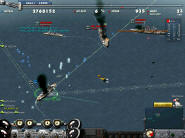 The game allows the player to ‘buy’, upgrade and fight using WWII-era ships
– gradually progressing from frigates and destroyers to either cruisers and
battleships or carriers, from the British, American, German or Japanese
navies. Most historical classes of capital ships are in the game – and also
some that never left the drawing board. This is especially relevant to
Germany which features some awesome units such as the Graf Zeppelin aircraft carrier,
or the H39 class of battleships – the huge successor to Bismarck. The game allows the player to ‘buy’, upgrade and fight using WWII-era ships
– gradually progressing from frigates and destroyers to either cruisers and
battleships or carriers, from the British, American, German or Japanese
navies. Most historical classes of capital ships are in the game – and also
some that never left the drawing board. This is especially relevant to
Germany which features some awesome units such as the Graf Zeppelin aircraft carrier,
or the H39 class of battleships – the huge successor to Bismarck.
The battles take place in real time, with up to as many as 128 players,
usually in two teams. The teams are arranged arbitrarily – that is, it’s not
Axis vs. Allies, but simply Alpha team vs. Bravo team with all types of
units in them. The game’s focus is exclusively on tactical combat between
the teams. The games range from skirmishes between small ships, to huge
battles with battleships gunning from long ranges, destroyers dashing in
with their torpedoes, and carriers launching dozens of aircraft.
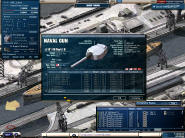 As mentioned above, the game is free to play until level 30, after which a
fairly modest fee of $7.99 US per month is applied. Optionally, players can
also pay more for premium accounts and items, and get bonuses like more
experience from each battle, some high-level crews and access to a couple of
exclusive cruiser classes. As mentioned above, the game is free to play until level 30, after which a
fairly modest fee of $7.99 US per month is applied. Optionally, players can
also pay more for premium accounts and items, and get bonuses like more
experience from each battle, some high-level crews and access to a couple of
exclusive cruiser classes.
One feature that you won’t find described on the game’s official website is
the addictiveness factor – it is a very catchy game, so a player who gets
into it can rightly expect constantly falling into the old trap of “one more
battle!” and “just a little longer until I can put on those new guns!”. On
the bright side, this means that a regular player probably won’t have any
reservations about having to pay the subscription fee. Consider yourselves
warned…
Installation
The game’s installation is surprisingly straightforward – you download the
game online, set up an account, and off you go. The download server is very
quick and the automatic updating utility has worked very smoothly for me. I
should also note in advance that the game’s netcode seems pretty good and
there’s hardly ever any lag. There are frequent but regular game server
outages due to maintenance but I suppose that’s for a good cause.
The documentation consists of a 60-page Microsoft Word manual you can
download from the official website. It has some basic information, but
that’s about it. Luckily, the game is very intuitive so you won’t need much
reading to get into it.
Building the Perfect Ship
The game greets players with nice loading and title screens, from which you
quickly proceed to your first stop – the port.
While certainly ‘vintage-looking’, the 2D port graphics are actually rather
attractive and the ships are nice to look at. When you start the game,
you’ll begin with a simple little frigate that’s easy to get ready for
combat. As you progress, you will get more and bigger ships, and more and
more upgrades, and managing them will actually become quite a challenge.
Should you go for bigger guns or faster speed? Should you choose more
torpedo launchers or get flak instead? There is actually a lot of real
numbers involved – the game models different types of shells, guns have
different firing speeds and traverse rates, and all seem to be modeled on
reasonably real figures. While you get a pretty big freedom of choice in weapons –
provided your crew can handle them – there are reasonable limits. You can
put an 18-inch gun on your cruiser, but its weight will sacrifice a lot of
speed. Likewise, you can give your ship a really fast, heavy engine but when
you combine it with heavy armor you’ll lose any speed advantages because
your ship will be too heavy. There is a speed meter that will tell you how
fast your ship will be able to move, and a hit-point meter to tell you how
much punishment it’ll be able to take – so you can quickly figure out what
effects upgrades have. Other items to put on your ship include aiming
systems, various aircraft, and of course the crew.
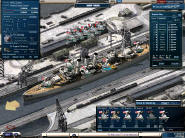 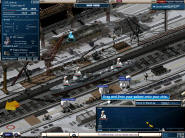 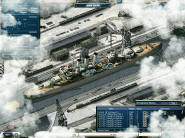
Some of the harbor menus (with some cheeky names
for the crew
 ) )
Your first frigate in the game will start with a newbie crew – and you can
recruit more whenever you want. The crew in the game is represented by
“Sailors” – although each sailor is actually a marker for a whole unit of
between 50 and perhaps as much as 200 crewmen. Through battle, they will
gain experience and you will have to choose specialized skills for them –
such as Bridge Operator, Gunner, Radio Man, Air Crew and so forth, which
will allow them to use new types of ships, weapons and other game features.
Bridge Operators are particularly key since they have to be “trained” to a
specific type of ship, so as your level improves you will have to choose the
crew’s path – the choice of nation and ship class will affect what ships you
will be able to progress to in the future. Needless to say, don’t expect to
be able to get both Bismarck and Iowa without having to train separate
German and American crews for each all the way from ‘nub’ trainees to
experts – a long, long process! The game allows you to have
pretty much as many crews and ships as you can afford to get with your
credits. You can also trade and ‘buy’ crews and ships for credits from other
players if you wish.
While the great deal of options in the harbor menu is a sign of a lot of
detail that went into the game, the micromanagement can also become a
frustrating chore at times. There are a few automated commands, but there
are
a lot of functions that the player will have to do by sheer mouse work. You
have to ‘buy’ guns and shells for them separately – for each mount; you have
to add more crew to your units, one by one, as they level up; you have to
check yourself when new weapons become available, and whether you actually
have enough crews of a high enough level to use them. There are some
oddities, too – like those Skua planes I bought for my cruiser that I could
neither use nor remove, because the game claimed I have no access to the
item yet. In short, there is a lot of detail but it comes at the price of
patience as the interface for dealing with it isn’t always intuitive.
First Impressions and Graphics
With your frigate out of port, the first thing you’ll need to do is
training. The training mission will teach you to move and shoot, controlling
your ship with keyboard and mouse.
Don’t let the training mission form your impression of the game – because
you probably won’t be too impressed. While it does work adequately for
training purposes, it’ll probably make the game look worse than it should,
for two reasons. First, any simulation grognard with expectations of a
naval combat game will likely be less then impressed as your frigate goes at
speeds of over 50kt, accelerating and slowing down with an unexpected
agility and shooting around at some suspiciously fast rates. But while Navy
Field isn’t oriented at die-hard realism, as I went on I found that the
balancing of the game’s ship classes and how they perform is actually very
appropriate.
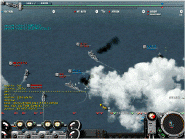 Second, there’s the graphics, which also do not impress at first sight.
It’s hard not to say anything about Navy Field’s looks – which are perhaps a
decade out of date. While the in-port management of your ship presents you
with a fairly detailed 2-D rendering, units in battle are represented by
very small 2-D sprites that often resemble toys. Other graphics are
rudimentary as well; the sea is not animated and doesn’t feature any water
effects, the ships sink near-instantly in a very basic animation of a few
frames, the field of view is fixed (there is a ‘3D view’ hotkey which is
actually a zoom function, but I found it rather useless as re-scaling does
not work well and makes fonts and other in-game cues unreadable). There is a
very ‘old-school’ feeling to them and some might like that, but the
graphics are not going to impress anyone. However, keep in mind that a good
game can do without great graphics if it has good gameplay. Second, there’s the graphics, which also do not impress at first sight.
It’s hard not to say anything about Navy Field’s looks – which are perhaps a
decade out of date. While the in-port management of your ship presents you
with a fairly detailed 2-D rendering, units in battle are represented by
very small 2-D sprites that often resemble toys. Other graphics are
rudimentary as well; the sea is not animated and doesn’t feature any water
effects, the ships sink near-instantly in a very basic animation of a few
frames, the field of view is fixed (there is a ‘3D view’ hotkey which is
actually a zoom function, but I found it rather useless as re-scaling does
not work well and makes fonts and other in-game cues unreadable). There is a
very ‘old-school’ feeling to them and some might like that, but the
graphics are not going to impress anyone. However, keep in mind that a good
game can do without great graphics if it has good gameplay.
One highlight of the graphics, though, is large battles – especially carrier
battles. The ‘fireworks’ really start flying with a lot of planes and ships
around, and as the sprites are rendered fairly smoothly, the big engagements
can really look good – with massive splashes of battleship guns ranging in,
light and heavy flak shooting in all directions, fans of torpedo trails
launched by cruisers in the water and burning planes falling through the
sky. I’m sure most players will be at least a little impressed when they
first see a big battle!
Game Modes and the Map
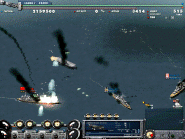 As I said - wait for your first few ‘real’ battles to form a first
impression of Navy Field. You’ll start getting the hang of your frigate,
though unfortunately you’ll probably be sunk often and without revenge early
in the game – such is the fate of being a tiny ship with just 3 small guns
to use. But try to participate in a few really big battles, and you’ll
probably get a pretty good idea of what this game is really all about. As I said - wait for your first few ‘real’ battles to form a first
impression of Navy Field. You’ll start getting the hang of your frigate,
though unfortunately you’ll probably be sunk often and without revenge early
in the game – such is the fate of being a tiny ship with just 3 small guns
to use. But try to participate in a few really big battles, and you’ll
probably get a pretty good idea of what this game is really all about.
To get into a multiplayer battle, Navy Field uses a map instead of the usual
chatrooms, server lists and channels – a nice touch. While the map features
the ports of London, Hamburg, New York, Tokyo and Busan (the latter being
for newbie players who haven’t picked their ‘nationality’ yet), I assure you
that it bears no resemblance whatsoever to an actual world map. Not that it
really matters. The map is divided into a number of areas, many of which
have special purposes – including trade areas and battle areas. 98% of all
the game’s action happens in Area 7, the head-to-head team combat area. All
battles in Area 7 are between two teams, on a plain map with a small island
in the middle, and a cloudy area in the north. While the idea of playing on
the same moderately-sized map over and over might not sound like a good plan
– it actually isn’t a real problem, rather it streamlines gameplay and
encourages players to build their tactics around their ships’ capabilities
instead of the environment. Hopefully more maps will be added later for
variety. There are other modes of gameplay than straight team showdowns -
including an intriguing-sounding “operation convoy” mode where players have
to escort merchant ships, but it seems that players have shunned them so far
in favour of direct competition. More modes for the game are being built as
we speak; the game website mentions a new feature called “harbor assault”
that is now being developed.
Even within the team vs. team battle mode, there is actually a lot of
variation. Some games will be big fleet showdowns of a hundred players;
others will prohibit the use of torpedoes or exclude carriers, or will be
only for the capital ships. Some of the most rewarding and flexible play is
actually found in small but dynamic Destroyer vs. Destroyer skirmishes of
perhaps a dozen players.
The Battle
Before the game begins, players choose their teams and put their ships in
formation. Although it usually takes a few minutes for enough players to
enter the game, the wait is reasonable. Navy Field also does a very good job
of creating balanced teams by assigning each class of ship a certain number
of ‘combat value’ points and giving a tally of ships by class on each team.
(Update: a new patch for Navy Field has just been
released, with a game mode where teams are balanced automatically, which
should help cut waiting times for games). You can expect a few calls of “CL move to team A!” or “Two DDs to Bravo!”
before the balance is finally shaken up by classes and the overall number of
points. On the whole, the wait for match start is usually worth it and
through my playing experiences there were few cases where teams were not
balanced – which made for some nail-biting competition!
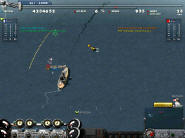 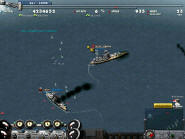 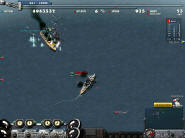
A Nelson battleship, one of the game's strongest units, desperately fends
off enemy attacks from air and surface, but is outnumbered.
Teamwork in the game seems to work very well despite the fact that it’s
almost never overtly organized (unless you happen to be in a ‘clan’, using a
voice communication program with your buddies). It goes to the game’s
credit, as most classes of ships really tend to do their proper jobs and
stick together. For instance, destroyers will usually stick together in
packs and rush to outflank the enemy fleet because if they don’t, they’ll
quickly find themselves surrounded by similar packs of enemy light ships. A
fleet that scatters or rushes forward quickly will find itself decimated.
Sure the teamwork is very “ad hoc” but it does usually work naturally and
well.
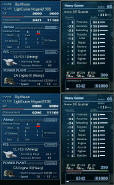 All classes of ships have their strengths. Even if your first frigate will
be cannon fodder even for the lowliest destroyers, I’ve actually discovered
that not all of these FFs are made equal – someone once had a torpedo-armed
frigate that could dash at a ridiculously-fast 70 knots! I was somewhat
disappointed that torpedoes don’t become available until one gets to level 8
and has a basic destroyer (takes a couple of days playing time) because
torpedoes do give small ships some big teeth, if used correctly. As I
already alluded, DDs are a really great class of ship to play with – they
can have pretty good guns later on, and their torpedo-carrying ability lets
really daring players even take a chance against the capital ships. Combat
between DDs is usually ruthless and is a big part of any good Navy Field
match. There is a gradient of cruisers – CL and CA ships, ranging from
slightly-oversized destroyers like the Dido class on the one end, to the
Panzershiffe – pocket battleships in the truest sense – on the other.
Likewise, playing for them is usually very dynamic and they probably offer
the most opportunities for tweaking and variation. Trading between Armor,
Firepower and Speed for the best combination, or creating special-purpose
ships, bristling with rows of torpedo launchers or a lot of anti-air
armament. BB’s – which actually include batteships and battlecruisers –
behave as expected, and act as very long-range artillery platforms. A
straddle from the big battleship guns, if delivered accurately, is fatal to
even the most resilient destroyers. I was especially impressed by skilled
battleship players who used scout planes to find targets just beyond their
line of sight, and pummel them into oblivion without ever being seen.
Carriers are something completely different; they are very vulnerable to
attack (although a few classes are decently armed), but stay far away from
the front line of battle and launch their planes to scout out and attack
targets on their own. Reconnaissance planes, fighters, dive bombers and
torpedo carriers round out a potent arsenal; needless to say, air power is
the bane of battleships and other big slow targets in the game. All classes of ships have their strengths. Even if your first frigate will
be cannon fodder even for the lowliest destroyers, I’ve actually discovered
that not all of these FFs are made equal – someone once had a torpedo-armed
frigate that could dash at a ridiculously-fast 70 knots! I was somewhat
disappointed that torpedoes don’t become available until one gets to level 8
and has a basic destroyer (takes a couple of days playing time) because
torpedoes do give small ships some big teeth, if used correctly. As I
already alluded, DDs are a really great class of ship to play with – they
can have pretty good guns later on, and their torpedo-carrying ability lets
really daring players even take a chance against the capital ships. Combat
between DDs is usually ruthless and is a big part of any good Navy Field
match. There is a gradient of cruisers – CL and CA ships, ranging from
slightly-oversized destroyers like the Dido class on the one end, to the
Panzershiffe – pocket battleships in the truest sense – on the other.
Likewise, playing for them is usually very dynamic and they probably offer
the most opportunities for tweaking and variation. Trading between Armor,
Firepower and Speed for the best combination, or creating special-purpose
ships, bristling with rows of torpedo launchers or a lot of anti-air
armament. BB’s – which actually include batteships and battlecruisers –
behave as expected, and act as very long-range artillery platforms. A
straddle from the big battleship guns, if delivered accurately, is fatal to
even the most resilient destroyers. I was especially impressed by skilled
battleship players who used scout planes to find targets just beyond their
line of sight, and pummel them into oblivion without ever being seen.
Carriers are something completely different; they are very vulnerable to
attack (although a few classes are decently armed), but stay far away from
the front line of battle and launch their planes to scout out and attack
targets on their own. Reconnaissance planes, fighters, dive bombers and
torpedo carriers round out a potent arsenal; needless to say, air power is
the bane of battleships and other big slow targets in the game.
Controlling the Ships
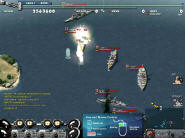 Of all the classes, the interface for aircraft carriers and aircraft in
general is possibly the most efficient, in part because most of its
functions are automated. There do seem to be some glitches related to
reporting downed aircraft but fortunately they don’t have any impact on
the game balance or points that are ultimately received (a few times the
game proudly announced that I shot down about 17 billion planes when a
burning Zero splashed down in the water near my ship). Most ships have light
flak that will fire on its own when planes approach. Of all the classes, the interface for aircraft carriers and aircraft in
general is possibly the most efficient, in part because most of its
functions are automated. There do seem to be some glitches related to
reporting downed aircraft but fortunately they don’t have any impact on
the game balance or points that are ultimately received (a few times the
game proudly announced that I shot down about 17 billion planes when a
burning Zero splashed down in the water near my ship). Most ships have light
flak that will fire on its own when planes approach.
Likewise, torpedoes are nicely modeled, and it is possible to select between
firing wide and narrow spreads, or using fast and slow speeds that will
cause torpedoes to run different ranges. By applying different
combinations to different launchers it’s possible to set up some great and
unexpected torpedo traps for any enemy that is foolish enough to get near
your ship!
Controlling guns is a somewhat different story. While the guns themselves
are modeled sufficiently with appropriate arcs, shell speeds, and effects of hits
at different angles, aiming them is sometimes problematic. Bringing guns
to bear on the target is not always a straightforward affair. There are two
types of fire control systems that can be put on the ship – automatic and
manual. Automatic fire control systems are aimed by simply clicking at a
spot on the map; manual systems are controlled with keyboard only, using
keys to turn guns and change the elevation.
While it seems like a fair tradeoff, it doesn’t work as smoothly as it
should. Automatic fire control is generally less precise than manual. There
is also no way to force a high-angle or low-angle shot, or a way to control
the guns separately. Also, all guns on a ship with an automatic FCS can only
be aimed on one bearing and even at close ranges it is not possible to make
them converge to hit a target more accurately (resulting in cases where only
the forward or only the aft guns will hit the target at point blank range,
instead of all at the same time).
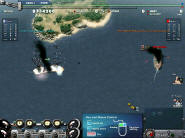 A manual FCS can do all these things but on the other hand it is unwieldy –
mainly because it forces the player to use the same set of keys for both
forward and rear guns, which have different turning arcs, or otherwise
control them separately (aim one, then aim the other). This is awkward
because, as should be expected, most guns on a ship cannot turn 360 degrees
– so if a ship maneuvers, they often have to be turned around, but this is
not easy to do with the keys. Either they have to be turned one-by-one,
wasting time, or all the ship’s guns have to be converged, and then turned
to their target and adjusted all the time as the ship maneuvers.
Considering the fast pace of the game, this becomes a real predicament for
targeting. A manual FCS can do all these things but on the other hand it is unwieldy –
mainly because it forces the player to use the same set of keys for both
forward and rear guns, which have different turning arcs, or otherwise
control them separately (aim one, then aim the other). This is awkward
because, as should be expected, most guns on a ship cannot turn 360 degrees
– so if a ship maneuvers, they often have to be turned around, but this is
not easy to do with the keys. Either they have to be turned one-by-one,
wasting time, or all the ship’s guns have to be converged, and then turned
to their target and adjusted all the time as the ship maneuvers.
Considering the fast pace of the game, this becomes a real predicament for
targeting.

On top of this is the game’s limited field of view. Battleships can fire
several ‘screens’ away from their position, which often makes it difficult
to figure out just where your guns are aiming or what your ship is doing
while you are aiming them. If a torpedo was suddenly sighted approaching the
ship there would be no way to maneuver it in a timely fashion. In fact
it’s possible that you would miss an obvious threat altogether this way. Yet
another problem is that there seem to be no key shortcuts for ship
maneuvering – only the mouse is used for turning the ship, which would be
impossible while the guns are being aimed somewhere far from your ship.
Thus, while still usable, the fire control often becomes unwieldy. While
understandable for ships of the WWII era, it could be managed better,
without compromising the player’s situational awareness.
Damage Modeling
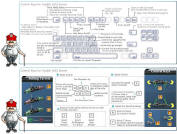 Another problem that should be mentioned is the damage modeling – or absence
thereof. As ships will lose hit points, their engines will eventually be
damaged and they will become slower and thus less maneuverable. A ship can
even be immobilized. Unfortunately, this is where damage modeling in Navy
Field ends. Ships’ weapons and other systems will never go out of order. While it seems to be possible for crews to take casualties, it rarely
happens and has no real effects. The only kind of weapons that can be lost
are aircraft from carriers. For the amount of detail Navy Field apparently
puts into modeling various guns and shell types, along with armor belts, the
damage modeling is disappointingly incomplete. Another problem that should be mentioned is the damage modeling – or absence
thereof. As ships will lose hit points, their engines will eventually be
damaged and they will become slower and thus less maneuverable. A ship can
even be immobilized. Unfortunately, this is where damage modeling in Navy
Field ends. Ships’ weapons and other systems will never go out of order. While it seems to be possible for crews to take casualties, it rarely
happens and has no real effects. The only kind of weapons that can be lost
are aircraft from carriers. For the amount of detail Navy Field apparently
puts into modeling various guns and shell types, along with armor belts, the
damage modeling is disappointingly incomplete.
Final Thoughts
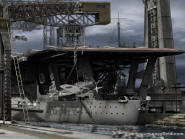 The gameplay in Navy Field is very balanced, fast-paced and
quite
challenging indeed – mostly in a good way. The greatest strength of Navy
Field lies in its variety, relative balance of power between ships and
weapon systems, and the players that inhabit the battlefield. The game does
not need to rely on AI and the fact that there are always smart, tricky
human players fighting with and against you makes the game very engaging and
unpredictable. In a sense, matches often play out like some sort of sport –
football would be a good comparison. The servers are currently
well-populated and you will always find sparring partners. With the long
time it takes to earn new ships and the restricted progression through ship
classes, combined with the sheer amount of weapons and upgrades for them,
there will be an almost infinite amount of new items and ways of playing the
game – and a massive variation of enemies to face as well. The game rewards
dedicated players well. The gameplay in Navy Field is very balanced, fast-paced and
quite
challenging indeed – mostly in a good way. The greatest strength of Navy
Field lies in its variety, relative balance of power between ships and
weapon systems, and the players that inhabit the battlefield. The game does
not need to rely on AI and the fact that there are always smart, tricky
human players fighting with and against you makes the game very engaging and
unpredictable. In a sense, matches often play out like some sort of sport –
football would be a good comparison. The servers are currently
well-populated and you will always find sparring partners. With the long
time it takes to earn new ships and the restricted progression through ship
classes, combined with the sheer amount of weapons and upgrades for them,
there will be an almost infinite amount of new items and ways of playing the
game – and a massive variation of enemies to face as well. The game rewards
dedicated players well.
My recommendation? If you have a lot of spare time, an interest in
competitive gaming that reflects naval warfare in a simplified fashion,
don’t mind outdated graphics or giving your mouse hand a solid workout –
give the 30-level trial a go. In your 30 levels, you’ll get a very good
taste of this game, especially with controlling destroyers, and will
probably have a good idea. Navy Field is not without its share of
deficiencies, but it’s a fun, varied, and highly addictive game. Again,
consider yourselves warned…
Publisher: SD EnterNET
Navy Field
Official Website
European
publisher: eFusion MMOG
|

